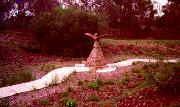
Tanderrum
Ellen José 1997
Aboriginal culture emphasises the land, water and sky as central to the spirit of the Australian landscape and part of the living spiritual domain. Together Aboriginal and Torres Strait islander artist Ellen José and Joy Murphy, Wurundjeri Tribal Elder, have imagined a vision for the creation of flight. Tanderrum (coming together) brings together concepts of pride, culture and spirit, and symbolises the coming together of the Kulin nation as one people.
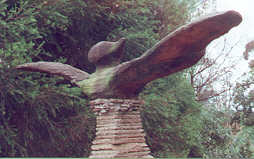 Constructed of Mt. William greenstone, Castlemaine slate, and redbox (the wood). The greenstone was used for axe-heads by Aboriginals prior to the arrival of Europeans in Australia. The axe-heads were traded between Aboriginal groups in South Eastern Australia. The sculpture was renovated in January 2008. Constructed of Mt. William greenstone, Castlemaine slate, and redbox (the wood). The greenstone was used for axe-heads by Aboriginals prior to the arrival of Europeans in Australia. The axe-heads were traded between Aboriginal groups in South Eastern Australia. The sculpture was renovated in January 2008.
An account of the Tanderrum ceremony, written by William Thomas during the 1840s.
Ceremony of Tanderrum, or Freedom of the Bush. There is not, perhaps, a more pleasing sight in a native encampment than when strange blacks arrive who have never been in the country before. Each comes with fire in hand (always bark), which is supposed to purify the air - the women and children in one direction, and the men and youths in another. They are ushered in generally by some of an intermediate tribe, who are friends of both parties, and have been engaged in forming an alliance or friendship between the tribes; the aged are brought forward and introduced. The ceremony of Tanderrum is commenced; the tribe visited may be seen lopping boughs from one tree and another, as varied as possible of each tree with leaves; each family has a separate seat, raised about 8 or 10 inches from the ground, on which in the centre sits the male and around him his male children, and the female and her sex of children have another seat.
Two fires are made, one for the males and the other for the females. The visitors are attended on the first day by those whose country they are come to visit, and not allowed to do anything for themselves; water is brought them which is carefully stirred by the attendant with a reed, and then given them to drink (males attend males and females females ); victuals are then brought and laid before them, consisting of as great a variety as the bush in the new country affords, if come-at-able; during this ceremony the greatest silence prevails, both by attendants and attended. You may sometimes perceive an aged man seated, the tear of gratitude stealing down his murky, wrinkled face. At night their mia-mias are made for them; conversation, &c., ensue. The meaning of this is a hearty welcome. As the boughs on which they sit are from various trees, so they are welcome to every tree in the forest. The water stirred with a reed means that no weapon shall ever be raised against them. On Saturday, the 22nd March 1845, at an encampment east of Melbourne, near 200 strangers arrived. The sight was imposing and affecting, especially their attendance upon that old chief Kuller Kullup, the oldest man I have ever seen among the blacks; he must have been near 80 years.
|



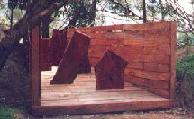



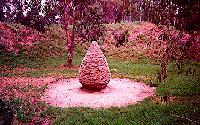
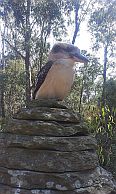

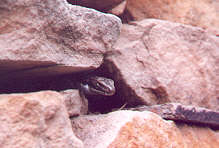
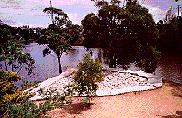

 Constructed of Mt. William greenstone, Castlemaine slate, and redbox (the wood). The greenstone was used for axe-heads by Aboriginals prior to the arrival of Europeans in Australia. The axe-heads were traded between Aboriginal groups in South Eastern Australia.
Constructed of Mt. William greenstone, Castlemaine slate, and redbox (the wood). The greenstone was used for axe-heads by Aboriginals prior to the arrival of Europeans in Australia. The axe-heads were traded between Aboriginal groups in South Eastern Australia.